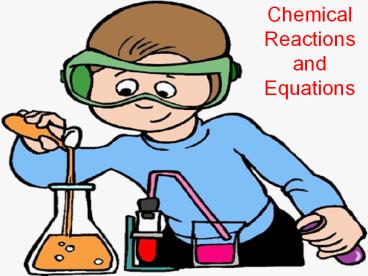Chemical Reactions and Equations PowerPoint PPT Presentation
Title: Chemical Reactions and Equations
1
Chemical Reactions and Equations
2
How can you tell if a chemical reaction has
occurred?
- Color change
- Heat produced/gets warm (exothermic)
- Heat absorbed/gets cold (endothermic)
- Gas produced (fizz)
- Solid produced/turns cloudy (precipitate)
- These are indications of
- CHEMICAL CHANGES
3
Physical Changes.
- DO NOT tell you a chemical reaction has
occurred! - Examples of physical changes
- Phase changes (solid-liquid-gas)
- Changes in shape
4
Is a chemical reaction occurring?
5
Is a chemical reaction occurring?
6
Is a chemical reaction occurring?
7
Is a chemical reaction occurring?
8
Is a chemical reaction occurring?
9
Is a chemical reaction occurring?
10
Is a chemical reaction occurring?
11
Is a chemical reaction occurring?
12
Is a chemical reaction occurring?
13
Chemical formulas
- are the words in the language of chemistry
- In the last unit you learned how to name
compounds and write their formulas. You learned
chemistry words like - KNO3 and NaBr
14
Chemical Equations
- are the sentences in the language of chemistry.
- You will put together the words (formulas) you
learned in the last unit to make sentences
(chemical equations) - As in English, sentences are more interesting
and give you more information than isolated
words
15
Punctuation and grammar
- In addition to needing words in your
sentences, you will also need some punctuation
and grammar to so your sentence makes sense and
is easy to understand. - Every chemical equation (sentence) has formulas
(words) as well as special symbols (punctuation)
16
Symbols used in Chemical Equations
and
yields
a gas forms
a precipitate forms
Heat needed (reaction is endothermic)
17
More symbols
catalyst
a catalyst is needed
(s) Solid phase
(l) Liquid phase
(g) Gas phase
(aq) aqueous (dissolved
in water)
18
Grammar
- Some basic rules for putting your chemical
equations together correctly - Like in English, always read from left to right
across the page - Start here end here
19
Grammar
- Some basic rules for putting your chemical
equations together correctly - 2) Each equation has two halves. The half left of
the arrow is the REACTANT side. - The half right of the arrow is the PRODUCT side.
- REACTANTS PRODUCTS
20
Chemical equations are easy!
- (compared to English!)
- You now know everything you need to know to write
grammatically correct chemical equations
21
Word Equations
- Translate the following word equation into an
chemical equation - Hydrogen chloride in the liquid phase and sodium
hydroxide in the solid phase yields aqueous
sodium chloride and water
22
Word Equations
- Hydrogen chloride in the liquid phase and sodium
hydroxide in the solid phase yields aqueous
sodium chloride and water - HCl (l) NaOH (s) NaCl (aq) H20

